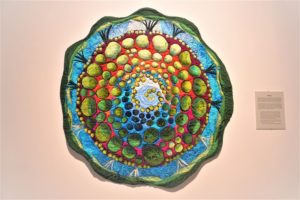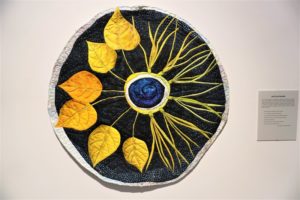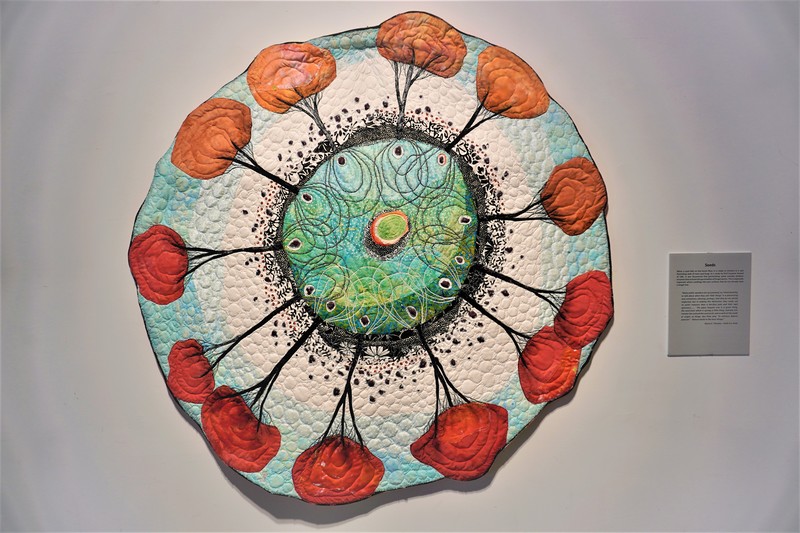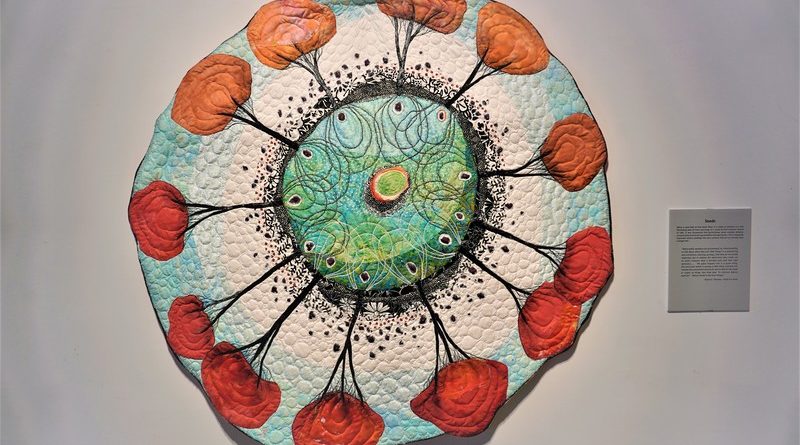New textile art exhibitions draw people to Almonte
Maureen Korp
Two textile art exhibitions at the Mississippi Valley Textile Museum in the village of Almonte, a short drive from Ottawa, are thoughtfully paired studies of interspecies communication. Woven Woods: A Journey through the Forest Floor is the work of Lorraine Roy. Knit Markers: Collaborating with Machines is the work of Greta Grip and Lee Jones. The artists’ work will be found inside Almonte’s old woollen mill, a national historic site.
In Woven Woods, the work of Lorraine Roy, we are shown carefully composed narrations of science and art. The trees are talking to one another, did you know?
The exhibition presents twelve wall hangings, each an intricately pieced fabric mandala — storylines told in units of twelve. Since ancient times worldwide, stories of cosmic order have been told in units of twelve. Twelve is the multiple of the four directions and three planes of the universe — worlds above, below, and ourselves here. Twelve is the marker of time, day and night. Lorraine Roy is working within this tradition.

Photo Ryan Milton
In Source 2016, for example, we follow a spiralling circle of energies from a blue outer ring of twelve thin trees into layers of complex inner realms —greens, browns, reds — all softly pebbled. Seven of the small trees are black-limbed, five are white-limbed; all reach into a canopy of green. At the top of the circle, stands a black tree framed in a white light. A small card text on the wall beside the artwork describes photosynthesis, the source: seeds become trees.
Each wall hanging is accompanied by an informative card—short texts taken from the artist’s studies of forestry and biodiversity, as well as quotes from others who have walked in the woods and listened to the trees, i.e., artists, poets, philosophers.

Photo Ryan Milton
Leaf and Needle 2017 evokes the yin-yang energies of Taoism. In this work, the artist arranged six yellow leaves on one side of a dark circle, six green seedlings on the other. The botanical process of ectomycorrhizal fungi—that is, how it is Douglas fir (green seedlings) and white birch (yellow leaves) share carbon with one another via an interspecies release of fungi — is described on the accompanying card text. Evidently, the forest’s trees know when to help each other, and do so.

Photo Ryan Milton
Tree in a Tree, 2017 delves further into the exhibition’s storyline of shared fungi among diverse species. In this work, twelve dark blue trees are shielded within white cubic forms. Along the disc’s outer edge are twelve seeds in four loose groupings of time and place. From year to year, seasons are never quite the same, are they?
The text for Tree in a Tree includes these words from poet Ralph Waldo Emerson: “Each particle is a microcosm, and faithfully renders the likeness of the world.” Reading these texts, we learn the importance of leaving woodlands, feral forests, alone. Dead trees are nests for living creatures. They should be left “…where they stand after they die.” Really?
A number of cities internationally now allow the growth of feral woodlands inside the urban core as a mediation of regional climate stress. In Berlin for example, the Natur-Park Südgelände was once a trainyard. Today it is a wild woodland in the heart of the city. People visit it only from an elevated walkway. The ground belongs to the forest and its creatures.
Lorraine Roy’s wall hangings urge us to learn from the forests how to be better human beings. What about the machinery of daily life?
In Knit Markers: Collaborating with Machines, Greta Grip and Lee Jones ask a number of gentle questions of ambient machinery. The exhibition includes two small machines, perched on little shelves. Walk by; look at each. As you do so, one machine will begin to knit a scarf. Walk away, the knitting stops. Walk over to the other little machine. Look. It cranks up and begins to unravel the fabric it knitted sometime beforehand. Which shall it be?

Photo Ryan Milton
There may be an answer in Wear your Heart on your Sleeve 2020-22, a performance work that Grip and Jones undertook with input from others. Twenty people permitted the artists to measure their heart rates. The artists then translated the heartbeat data of the twenty souls into machine programming. Outcome? Twenty knitted shawls. Not one the same as another.
In the exhibition, the shawls have been hung on a rack indifferently, casually. They are softly multi-coloured. As a group, they appear more alike than different. So might we all be.
Might we walk more easily down the street, into the woods if we wore our hearts on our sleeves?
Continuing until July 22, 2023
Woven Woods: a journey through the forest floor
by Lorraine Roy
Knit Markers: Collaborating with machines
by Lee Jones and Greta Grip
Mississippi Valley Textile Museum
3 Rosamond Street East, Almonte, Ontario
By donation; wheelchair accessible
Tuesday to Saturday,
1:00 pm-4:00 pm

Photo Ryan Milton
